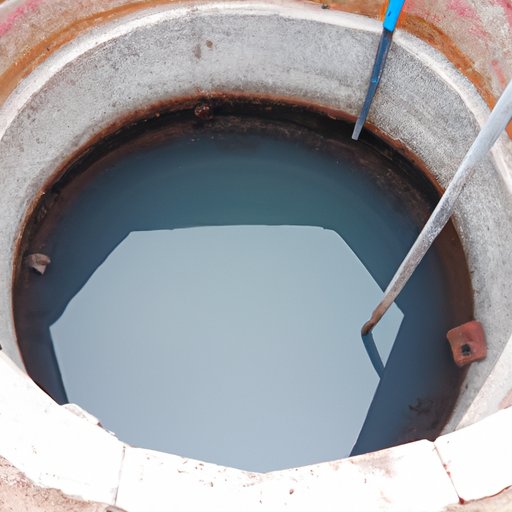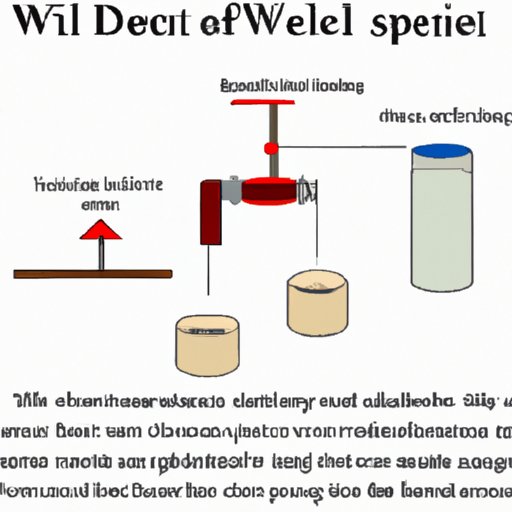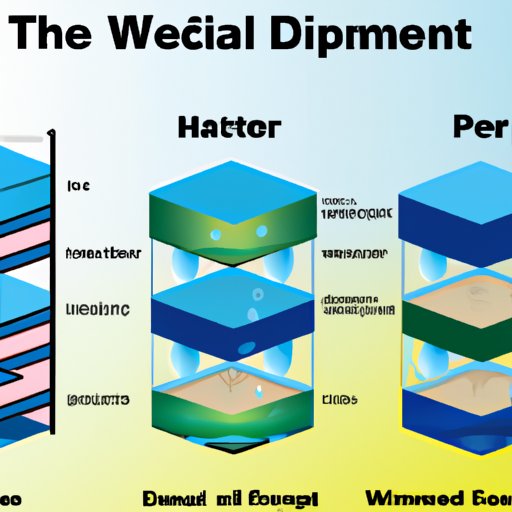Introduction
When building a well for drinking water, it is important to understand how deep it should be in order to provide a safe and reliable source of clean water. This article provides an overview of the science and essential considerations behind well depth for drinking water, including understanding groundwater movement, examining recharge rates, identifying local regulations, assessing soil type and porosity, and more.
Exploring the Science Behind Well Depth for Drinking Water
Before determining how deep a well should be for drinking water, it is important to understand the science behind well depth. According to the United States Geological Survey (USGS), “the depth of a well is the distance from the ground surface to the bottom of the hole” 1. The deeper the well, the better the chances are of finding water that is free from contaminants.
In order to understand how deep a well should be for drinking water, it is also important to understand the movement of groundwater. Groundwater is drawn from underground aquifers, and it moves slowly through the subsurface layers of soil and rock. The speed at which groundwater moves depends on the porosity of the soil and the amount of water present. The recharge rate of an aquifer is the rate at which new water enters the aquifer, and this can vary greatly depending on the local environment and weather conditions.

Essential Considerations When Determining Well Depth for Potable Water
When determining how deep a well should be for drinking water, there are several essential considerations that must be taken into account. First and foremost, it is important to be aware of any local regulations or requirements regarding well depth. In many areas, there are minimum depth requirements for drinking water wells, and these can vary depending on the location.
It is also important to consider the soil type and porosity when determining well depth. Soil type can affect the porosity of the aquifer, which in turn affects the amount of water that can be stored and the speed at which the water moves. The porosity of the aquifer can also determine how deep the well needs to be in order to access uncontaminated water.
Finally, it is important to assess the quality of the groundwater when determining well depth for drinking water. Groundwater can become contaminated over time due to pollutants in the soil or runoff from nearby sources, and it is important to ensure that the well is deep enough to access clean water.

An Overview of Well Depths for Safe Drinking Water
When considering how deep a well should be for drinking water, there are two main types of wells: shallow wells and deep wells. Shallow wells are typically less than 30 feet deep, while deep wells can range from 30 to hundreds of feet deep. In some cases, very deep wells can reach depths of 1,000 feet or more.
A Guide to Choosing the Right Well Depth for Drinking Water
When choosing a well depth for drinking water, it is important to identify the right location. The location of the well can have a major impact on the depth of the well, as well as the quality of the water. It is important to work with a professional who has experience in well drilling to ensure that the well is located in the optimal spot.
It is also important to assess the costs associated with different well depths. The cost of drilling a deep well can be significantly higher than drilling a shallow well, so it is important to weigh the costs against the benefits of each type of well.

Understanding the Role of Well Depth in Providing Clean Drinking Water
Well depth plays an important role in providing clean drinking water. Deeper wells are less likely to be contaminated by pollutants in the soil or runoff from nearby sources, and they can also provide a more reliable supply of water. Shallow wells can draw water from shallow aquifers, but these aquifers can be more easily depleted during periods of drought.

Factors That Influence Well Depth for Drinking Water
There are several factors that can influence well depth for drinking water. Geology, climate, and topography all play a role in determining the depth of a well. The type of rock and soil in the area can affect the porosity of the aquifer, while the climate can affect the recharge rate. Topography can also influence the depth of a well, as steeper slopes can lead to greater depths.
Examining the Pros and Cons of Different Well Depths for Drinking Water
When deciding how deep a well should be for drinking water, it is important to examine the pros and cons of different well depths. Shallow wells can be less expensive to drill, but they are more susceptible to contamination and can be easily depleted during periods of drought. Deep wells can provide a more reliable source of clean water, but they can be more costly to drill.
Conclusion
When building a well for drinking water, it is important to understand how deep it should be in order to provide a safe and reliable source of clean water. This article provided an overview of the science and essential considerations behind well depth for drinking water, including understanding groundwater movement, examining recharge rates, identifying local regulations, assessing soil type and porosity, and more. Factors such as geology, climate, and topography can all influence well depth, and it is important to weigh the benefits and drawbacks of both shallow and deep wells when deciding how deep a well should be.
In conclusion, well depth is an important factor when it comes to providing clean drinking water. It is important to work with professionals to identify the optimal location for the well and to assess the costs associated with different well depths. With the right well depth, it is possible to access a safe and reliable source of clean drinking water.
(Note: Is this article not meeting your expectations? Do you have knowledge or insights to share? Unlock new opportunities and expand your reach by joining our authors team. Click Registration to join us and share your expertise with our readers.)
